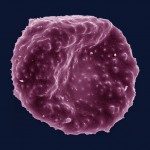Lien vers Pubmed [PMID] – 27267365
Malar. J. 2016 06;15:309
BACKGROUND: Malaria is a major parasitic disease, affecting millions of people in endemic areas. Plasmodium falciparum parasites are responsible for the most severe cases and its resistance to anti-malarial drugs is notorious. This is a possible obstacle to the effectiveness of intermittent preventive treatment (IPT) based on sulfadoxine-pyrimethamine (SP) cures administrated to pregnant women (IPTp) during their pregnancy. As this intervention is recommended in Angola since 2006, it has assessed, in this country, the molecular profiles in P. falciparum dhfr and dhps, two polymorphic genes associated to pyrimethamine and sulfadoxine resistance, respectively.
METHODS: Blood samples from 52 falciparum patients were collected in Lubango, Angola and pfdhfr and pfdhps polymorphisms were analysed using nested-PCR and DNA sequencing.
RESULTS: In the pfdhfr gene, the 108N mutation was almost fixed (98 %), followed by 59R (63 %), 51I (46 %), 50R and 164L (2 %, respectively). No 16V/S mutations were found. The most common double mutant genotype was CNRN (59 + 108; 46 %), followed by CICN (51 + 108; 29 %) whereas IRN (51 + 59 + 108; 15 %), CNRNVL (59 + 108 + 164; 2 %) and RICN (50 + 51 + 108; 2 %) triple mutant genotypes were detected. Investigations of the pfdhps gene showed that the 437G mutation was the most prevalent (97 %). Only two and one samples disclosed the 540E (7 %) and the 436A (3 %), respectively. Single mutant SGKAA (437; 86 %) was higher than SGEAA (437 + 540; 7 %) or AGKAA (436 + 437; 3 %) double mutants genotypes. No polymorphism was detected at codons 581G and 613T/S. Combining pfdhfr and pfdhps alleles two triple mutant haplotypes (double mutant in dhfr and single mutant in dhps) were observed: the ACICNVI/SGKAA in 14 (56 %) samples and the ACNRNVI/SGKAA in five (20 %) samples. One quadruple mutant haplotype was detected (ACIRNVI/SGKAA) in six (24 %) P. falciparum samples. No quintuple pfdhfr-pfdhps mutant was noted.
CONCLUSION: pfdhfr and pfdhps gene mutations in isolates from Lubango are suggestive of a low-grade SP resistance and IPT for pregnant women and infant based on SP treatment could be effective. Routine molecular studies targeting polymorphism in these two genes need to be routinely conducted at country level.

